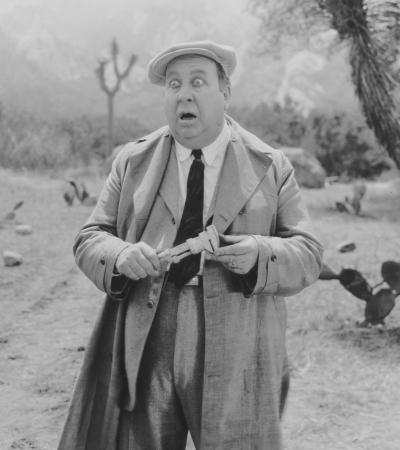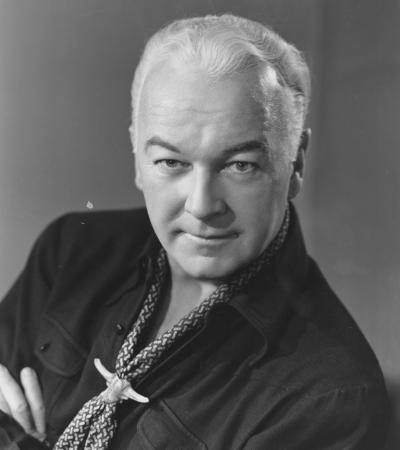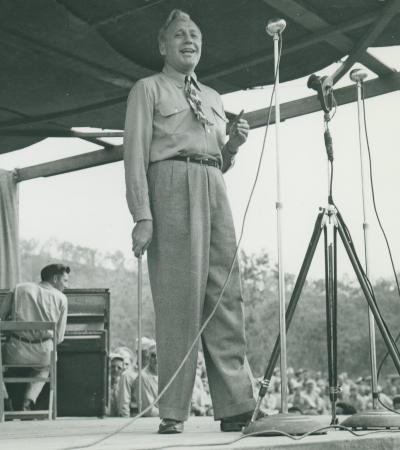Film, radio, and television gained popularity over the first half of the twentieth century and into the postwar period. New technology allowed the entertainment industry to transition from theater and live music to these media that could be recorded and widely distributed. For the first time, wide swaths of the nation could be exposed to the same audio-visual material. Demand for these media skyrocketed, creating new jobs for actors, musicians, and broadcasters. Modern American entertainment was born.
Film, the oldest of the three media, can trace its beginnings to the invention of photography in 1839. Once live images could be captured, entrepreneurs hoped to similarly capture sequences of events. Over the next half-century, various machines were invented to capture the magic of a moving picture. Among these were the zoöpraxiscope, the electrotachyscope, and the kinetoscope, though none of these was suitable for capturing long sequences or projecting them effectively for an audience. In the 1880s, however, the invention of film reels and cameras designed to use them allowed the capture of long sequences of film on a small amount of area. By 1900, these silent moving pictures were popular with audiences.
The late 1920s saw the invention of talkies—films with audio tracks—as well as the first real film stars, such as Charlie Chaplin. Cinemas were raised as locations to view these films, and film became a multi-million dollar industry with the beginnings of Hollywood in California. The 1930s saw the arrival of films with true color, which replaced the much more expensive process of coloring each frame individually. Popular with audiences, color films brought more wealth to Hollywood, and solidified film as a successful industry.
By the end of the Second World War and the arrival of the 1950s, film was at the center of American life. Movies were, and remain, a popular pastime, and were accessible for Americans of every walk of life. Successful movie stars make a great deal of money, and are among the most famous American celebrities. Today, film is a hundred billion dollar industry annually, and Hollywood is one of America’s best known cultural sites.
Invented in the early twentieth century, radio provided a form of entertainment that Americans could access in their homes. The first radio stations launched in 1920, allowing Americans access to sports, music, and events that were previously reserved for those who could afford them. By the 1930s, radios could be found in automobiles, and as the price of these cars decreased, Americans could access this leisure activity even while on the move.
In 1934, the government moved to regulate the radio industry with the Communications Act that established the Federal Communications Commission. This act encouraged the government to make radio accessible to all Americans, and allowed the government to use this system of radio stations in times of war. The 1930s also saw the rise of the first generation of radio stars, including Jack Benny, Orson Welles, and Bob Hope.
Today, radio is split between amplitude modulation (AM), frequency modulation (FM), and digital formats. Though no longer a dominant form of media in this country, the radio industry is still worth over twenty billion dollars per year globally. Modern radio is dominated by networks of commercial broadcasters and continues to be regulated by the Federal Communications Commission.
The first television broadcasts took place in the 1920s. Unlike film, television did not rely on physical pictures on a roll of film, but rather digital images sent by radio wave that would be converted to moving images in a television set. At first, there were two types of televisions, mechanical and electronic. Electronic televisions had an advantage over mechanical televisions due to their larger size, and mechanical televisions fell out of favor by the 1930s, leaving only electronic televisions, which soon grew commercially among the American public.
By the middle of the 1950s, television was an important part of the American home. Indeed, by 1954, over half of American homes had a television. This led to the rise of the first television stars. Lucille Ball, Andy Griffith, Jack Benny, Ozzie and Harriet Nelson, and other actors were able to gain fame and wealth through their leading roles in the 1950s and 1960s.
Over the years, television has gone through many changes. Color television had been introduced in the 1940s, a huge step forward for the industry, but it did not become widespread until the 1960s. Today, high definition broadcasts are commonplace. Some television sets are even capable of showing 3D content. Many modern televisions are Smart TVs, capable of connecting to the internet. In 2020, the television industry is worth nearly one hundred billion dollars per year.
So, since the advent of modern popular culture, film, radio, and television have dominated the American media landscape. Worth billions of dollars combined, the media have overcome their complicated technological beginnings to become staples of the American culture.




